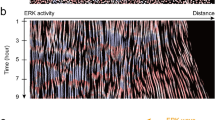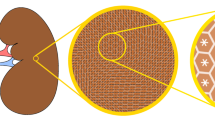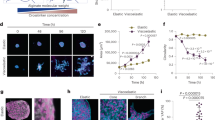Abstract
Biological processes such as embryogenesis, wound healing and cancer progression rely on the ability of epithelial cells to coordinate their mechanical activity over length scales that are orders of magnitude larger than the typical cellular size1. Although this process is regulated by various signalling pathways2, it has recently become evident that this coordination can be understood using physics tools, of which liquid crystal order is a prominent example3,4. However, prior studies have given inconsistent results in this respect. Whereas nematic order is often invoked in the interpretation of experimental data3,4,5, computational models have instead suggested that hexatic order could serve as a linchpin for collective migration in confluent cell layers6,7,8. In this Letter, we resolve this dilemma. Using a combination of in vitro experiments, numerical simulations and analytical work, we demonstrate that both nematic and hexatic order are present in epithelial layers, with the former being dominant at large length scales and the latter at small length scales. In cells on uncoated glass, these different types of liquid crystal order cross over at a length scale of the order of ten cell sizes. Our work provides a framework for deciphering epithelial structure and may lead to a predictive mesoscopic theory of tissues9.
This is a preview of subscription content, access via your institution
Access options
Access Nature and 54 other Nature Portfolio journals
Get Nature+, our best-value online-access subscription
$29.99 / 30 days
cancel any time
Subscribe to this journal
Receive 12 print issues and online access
$209.00 per year
only $17.42 per issue
Buy this article
- Purchase on Springer Link
- Instant access to full article PDF
Prices may be subject to local taxes which are calculated during checkout



Similar content being viewed by others
Data availability
The data that support the findings of this study and the code for data analysis are openly available in GitHub at https://github.com/hexanematic/orientation_tracker. Source data are provided with this paper.
References
Friedl, P. & Gilmour, D. Collective cell migration in morphogenesis, regeneration and cancer. Nat. Rev. Mol. Cell Biol. 10, 445–457 (2009).
De Pascalis, C. & Etienne-Manneville, S. Single and collective cell migration: the mechanics of adhesions. Mol. Biol. Cell 28, 1833 (2017).
Duclos, G., Erlenkämper, C., Joanny, J.-F. & Silberzan, P. Topological defects in confined populations of spindle-shaped cells. Nat. Phys. 13, 58 (2016).
Saw, T. B. et al. Topological defects in epithelia govern cell death and extrusion. Nature 544, 212 (2017).
Kawaguchi, K., Kageyama, R. & Sano, M. Topological defects control collective dynamics in neural progenitor cell cultures. Nature 545, 327 (2017).
Li, Y.-W. & Ciamarra, M. P. Role of cell deformability in the two-dimensional melting of biological tissues. Phys. Rev. Mater. 2, 045602 (2018).
Durand, M. & Heu, J. Thermally driven order-disorder transition in two-dimensional soft cellular systems. Phys. Rev. Lett. 123, 188001 (2019).
Pasupalak, A., Yan-Wei, L., Ni, R. & Pica Ciamarra, M. Hexatic phase in a model of active biological tissues. Soft Matter 16, 3914 (2020).
Armengol Collado, J.-M., Carenza, L. N. & Giomi, L. Hydrodynamics and multiscale order in confluent epithelia. Preprint at https://arxiv.org/abs/2202.00651 (2022).
Balasubramaniam, L. et al. Investigating the nature of active forces in tissues reveals how contractile cells can form extensile monolayers. Nat. Mater. 20, 1156 (2021).
Maroudas-Sacks, Y. et al. Topological defects in the nematic order of actin fibres as organization centres of hydra morphogenesis. Nat. Phys. 17, 251 (2021).
Hoffmann, L. A., Carenza, L. N., Eckert, J. & Giomi, L. Theory of defect-mediated morphogenesis. Sci. Adv. 8, eabk2712 (2022).
Streichan, S. J., Lefebvre, M. F., Noll, N., Wieschaus, E. F. & Shraiman, B. I. Global morphogenetic flow is accurately predicted by the spatial distribution of myosin motors. eLife 7, e27454 (2018).
Bigun, J. Optimal Orientation Detection of Linear Symmetry (Linköping Univ. Electronic Press, 1987).
Aubouy, M., Jiang, Y., Glazier, J. A. & Graner, F. A texture tensor to quantify deformations. Granul. Matter 5, 67 (2003).
Asipauskas, M., Aubouy, M., Glazier, J. A., Graner, F. & Jiang, Y. A texture tensor to quantify deformations: the example of two-dimensional flowing foams. Granul. Matter 5, 71 (2003).
Chaikin, P. M. & Lubensky, T. C. Principles of Condensed Matter Physics (Cambridge Univ. Press, 1995).
Giomi, L. Geometry and topology of turbulence in active nematics. Phys. Rev. X 5, 031003 (2015).
Friedel, G. Les états mésomorphes de la matière. Ann. Phys. 9, 273 (1922).
Giomi, L., Toner, J. & Sarkar, N. Long-ranged order and flow alignment in sheared p-atic liquid crystals. Phys. Rev. Lett. 129, 067801 (2022).
Giomi, L., Toner, J. & Sarkar, N. Hydrodynamic theory of p-atic liquid crystals. Phys. Rev. E 106, 024701 (2022).
Virga, E. G. Octupolar order in two dimensions. Eur. Phys. J. E 38, 63 (2015).
Halperin, B. I. & Nelson, D. R. Theory of two-dimensional melting. Phys. Rev. Lett. 41, 121 (1978).
Nelson, D. R. & Halperin, B. I. Dislocation-mediated melting in two dimensions. Phys. Rev. B 19, 2457 (1979).
Bernard, E. P. & Krauth, W. Two-step melting in two dimensions: first-order liquid-hexatic transition. Phys. Rev. Lett. 107, 155704 (2011).
Digregorio, P. et al. Full phase diagram of active brownian disks: from melting to motility-induced phase separation. Phys. Rev. Lett. 121, 098003 (2018).
Yamada, S., Pokutta, S., Drees, F., Weis, W. I. & Nelson, W. J. Deconstructing the cadherin-catenin-actin complex. Cell 123, 889 (2005).
Loewe, B., Chiang, M., Marenduzzo, D. & Marchetti, M. C. Solid-liquid transition of deformable and overlapping active particles. Phys. Rev. Lett. 125, 038003 (2020).
Monfared, S., Ravichandran, G., Andrade, J. & Doostmohammadi, A. Mechanical basis and topological routes to cell elimination. eLife 12, e82435 (2023).
Carenza, L. N., Gonnella, G., Lamura, A., Negro, G. & Tiribocchi, A. Lattice boltzmann methods and active fluids. Eur. Phys. J. E 42, 81 (2019).
Bi, D., Yang, X., Marchetti, M. C. & Manning, M. L. Motility-driven glass and jamming transitions in biological tissues. Phys. Rev. X 6, 021011 (2016).
Frenkel, D. & Eppenga, R. Evidence for algebraic orientational order in a two-dimensional hard-core nematic. Phys. Rev. A 31, 1776 (1985).
Bagchi, K., Andersen, H. C. & Swope, W. Computer simulation study of the melting transition in two dimensions. Phys. Rev. Lett. 76, 255 (1996).
Kittel, C. & McEuen, P. Introduction to Solid State Physics, Vol. 8 (Wiley, 1996).
Eckert, J., Ladoux, B., Giomi, L., & Schmidt, T. Hexanematic crossover in epithelial monolayers depends on cell adhesion and cell density. Preprint at bioRxiv https://doi.org/10.1101/2022.10.07.511294 (2022).
Majmudar, T. S. & Behringer, R. P. Contact force measurements and stress-induced anisotropy in granular materials. Nature 435, 1079 (2005).
Gao, G.-J. J., Holcomb, M. C., Thomas, J. H. & Blawzdziewicz, J. Embryo as an active granular fluid: stress-coordinated cellular constriction chains. J. Phys. Condens. Matter 28, 414021 (2016).
Keber, F. C. et al. Topology and dynamics of active nematic vesicles. Science 345, 1135 (2014).
Guillamat, P., Blanch-Mercader, C., Kruse, K. & Roux, A. Integer topological defects organize stresses driving tissue morphogenesis. Nat. Mater. 21, 588–597 (2022).
Blankenship, J. T., Backovic, S. T., Sanny, J., Weitz, O. & Zallen, J. A. Multicellular rosette formation links planar cell polarity to tissue morphogenesis. Dev. Cell 11, 459 (2006).
Rauzi, M. Cell intercalation in a simple epithelium. Phil. Trans. R. Soc. B 375, 20190552 (2020).
Haeger, A. et al. Collective cancer invasion forms an integrin-dependent radioresistant niche. J. Exp. Med. 217, e20181184 (2020).
Serra-Picamal, X. et al. Mechanical waves during tissue expansion. Nat. Phys. 8, 628 (2012).
Acknowledgements
This work is supported by the European Union via the ERC-CoGgrant HexaTissue (L.N.C., D.K. and L.G.) and by the Netherlands Organization for Scientific Research (NWO/OCW) as part of the research programme ‘The active matter physics of collective metastasis’ with project number Science-XL 2019.022 (J.-M.A.-C. and L.G.). Part of this work was carried out on the Dutch national e-infrastructure with the support of SURF through Grant no. 2021.028 for computational time. J.E. and L.G. thank M. Gloerich, UMC Utrecht, for providing us with the MDCK cells. L.N.C. thanks G. Negro, University of Edinburgh, for providing us with the data for passive Brownian particles. All authors thank L. Hoffmann for fruitful discussions.
Author information
Authors and Affiliations
Contributions
J.-M.A.-C. performed analytic work and Voronoi model simulations and analysed data. L.N.C. coordinated the research, performed the multiphase-field simulations and analysed data. J.E. performed analytic work and experiments and analysed data. D.K. performed analytic work and analysed data. L.G. devised and coordinated the research. All authors wrote the paper. J.-M.A.-C., L.N.C., J.E. and D.K. contributed equally to this work.
Corresponding author
Ethics declarations
Competing interests
The authors declare no competing interests.
Peer review
Peer review information
Nature Physics thanks Joshua Shaevitz and the other, anonymous, reviewer(s) for their contribution to the peer review of this work.
Additional information
Publisher’s note Springer Nature remains neutral with regard to jurisdictional claims in published maps and institutional affiliations.
Extended data
Extended Data Fig. 1 Misidentification of nematic defects in a honeycomb lattice.
Because of the 6-fold symmetry of regular hexagons, there is no well defined longitudinal direction, thus it is possible to construct a defective configuration, featuring a pair of ± 1/2 disclinations, even though the lattice is defect free.
Extended Data Fig. 2 Probability distribution of cell coordination number for experiments and simulations.
Data are presented as mean values of the total number of analyzed images ± s.e.m. Sample size (number of points per bar): experiment n = 68, Mpf simulations n = 286, Voronoi simulations n = 100. The mean values of the distribution of the coordination number are: 5.8 ± 0.9 (mean ± s.d.) for experiments and 5.9 ± 0.9 (mean ± s.d.) for multiphase field simulations and 6.0 ± 0.6 (mean ± s.d.) for Voronoi simulations.
Extended Data Fig. 3 Probability distribution of the order parameter’s amplitude γ2 and γ6 for the Voronoi and Mpf model as a function of the main simulation parameters.
(a) Probablity distribution of ∣γp∣, p = 2, 6 for the self-propelled Voronoi model when varying the shape index p0. At increasing p0, the distribution for the hexatic shape function flattens and it peaks at lower values. The opposite happens for p = 2, which turns from being negligible to exhibit a comparable peak value to the one of the hexatic symmetry. (b) Same effect when varying the self-propulsion v0. In this case, we lower p0 = 3.7 in order to capture the melting transition: there is no substantial variation of the profiles when varying v0 at p0 = 3.9 as the system is deeply in the liquid phase. These observations are coherent with the unjamming transition that has been reported for this particle-based model in Ref. 31. (c) Probablity distribution of ∣γp∣, p = 2, 6 for the Mpf model when varying the velocity of self-propulsion v0. Analogously to the case of the Voronoi model, ∣γ6∣ (∣γ2∣) is larger (smaller) at low (high) v0 values. The simulations of both the Voronoi and Mpf have been performed under the same values of model parameters provided in Table 1, except for the shape index p0 and self-propulsion velocity which are varied as reported in the legend of panels (a-c). Data are presented as mean values of the total number of analyzed images ± s.d. Sample size (number of points per bar): Voronoi simulations n = 100 (panels (a-b), Mpf simulations n = 286 (panel (c)).
Extended Data Fig. 4 Orientational order parameter at different length scales.
Nematic (a) and hexatic (b) shape parameter Γ2 and Γ6 at different values of the coarse-graining radius R, expressed in units of the average cell size Rcell = 7.4μm for the same experimental image as in Fig. 3 of the main text. In both top and bottom panels, positive and negative defects are marked in red and blue respectively ( ± 1/2 for nematic and ± 1/6 for hexatic). The spatial resolution of the shape parameter is the same on both panels, but the number of orientation markers in panel (b) is half of that used in panel (a) for sake of clarity.
Extended Data Fig. 5 Misidentification of singular lines in p − atic liquid crystals.
Assigning a 2-fold orientation to individual cells leads to a misdetection of their orientational order, including what concerns the identification of topological defects. (a) The best known example of an analogous misdetection, is obtained when one attempts to track the orientation of the nematic director in the surrounding of ± 1/2 disclinations using a vector field, whose rotational symmetry is 1-fold, rather than 2-fold as required. In this case, the most visible signature of the misdetection consists of a singular line, across which the vector field “jumps” by an angle of 180°. This singular line is marked by oppositely oriented red arrows in the panel. (b) The same effect can be observed when a pair of ± 1/6 hexatic defects is tracked using a 2-fold orientation field. In this case, the 2-fold orientation field jumps by 60°, as indicated by red segments. In general, detecting a ± n/p defect, with n a natural number, using an arbitrary q-fold orientation field, with p ≠ q, yields a singular line where the q-fold orientation jumps by an angle of \(2\pi \min [n/p,| p-nq| /(pq)]\) as demonstrated in the Supplemenatry Sec. S3.
Extended Data Fig. 6 Decay of defect density in simulations.
Decay of the defect density at varying the coarse-graining radius in simulations of the multiphase field model (a) and Voronoi model (b). The scaling of the multiphase field model data is compatible with that shown in panel d of Fig. 3 in the main text for experimental data. In the right panel, curves of oppositely charged defects overlap exactly. Data are presented as mean values of the total number of analyzed configurations ± s.e.m. Sample size (number of configurations analyzed per point): Mpf simulations n = 286, Voronoi simulations n = 100.
Extended Data Fig. 7 Nematic filamentary structures.
Computer reconstruction of MDCK II cell monolayer (same sample as in Fig. 3b,c) with the cells highlighted based on the orientation of the coarse-grained nematic director (solid lines) for R = 4.5Rcell. The emergence of filamentary structures is especially evident in proximity of the topological defects.
Extended Data Fig. 8 Decay of p − fold orientational order.
Magnitude of Γp, with p = 2, …, 6, versus the coarse-graining radius R measured for experimental (a) and numerical Mpf data (b). Orientational order decays with power law behavior \(| {\Gamma }_{p}| \sim {(R/{R}_{{{{\rm{cell}}}}})}^{-{\eta }_{p}/2}\). We notice that η3, η5 ≈ 2, the critical value corresponding to a disordered state, therefore suggesting 3 − and 5 − fold symmetry to be significantly suppressed in our experimental and Mpf model tissues. For p = 4, on the other hand, η4 = 1.38 ± 0.01 in experiments and η4 = 1.16 ± 0.03 in simulations, thus suggesting the presence of tetratic orientational order. This behavior is, however, the consequence of the degeneracy of the shape funciton illustrated in Section S1 of the Supplement. Hence, the observation of a residual tetratic order follows from the leading nematic order. Finally, we stress that the largest contribution at small and large scale is given by the hexatic and nematic orded parameter, respectively, for both experimental and simulation data. Data are presented as mean values of the total number of analyzed configurations ± s.e.m. (see Methods section). Sample size (number of configurations analyzed per point): experiment n = 68, Mpf simulations n = 286.
Extended Data Fig. 9 Spatial correlation function of experimental and Mpf data.
Two-point spatial correlation function \(\left\langle {\gamma }_{p}^{* }({{{\boldsymbol{r}}}}){\gamma }_{p}({{{\boldsymbol{0}}}})\right\rangle\), normalized with respect to the magnitude of the shape parameter ∣Γp∣ for p = 2 and p = 6. Data are presented as mean values of the total number of analyzed configurations ± s.d. Sample size (number of configurations analyzed per point): experiment n = 68, Mpf simulations n = 286.
Extended Data Fig. 10 Orientational order decay and correlation functions of Voronoi model.
(a) Restricting the cell to be Voronoi polygons artificially enhances their hexagonality thereby favoring hexatic order, which then prevails at all scales. (b) Spatial correlation of the shape functions γ2 and γ6. Unlike the correlation functions shown in Fig. E9, corresponding to the experimental results and Mpf simulations, the residual hexatic order causes \(\left\langle {\gamma }_{6}^{* }({{{\boldsymbol{r}}}}){\gamma }_{6}({{{\boldsymbol{0}}}})\right\rangle\) to be greater than \(\left\langle {\gamma }_{2}^{* }({{{\boldsymbol{r}}}}){\gamma }_{2}({{{\boldsymbol{0}}}})\right\rangle\) at large length scales. These simulations have been performed under the same parameter values provided in Table 1 of the main text. Data are presented as mean values of the total number of analyzed configurations ± s.d. Sample size (number of configurations analyzed per point) n = 100.
Supplementary information
Supplementary Information
Supplementary Discussion: Orientational order in two-dimensional p-atic liquid crystals, the p-fold shape tensor and defect representation in p-atic liquid crystals, and Figs. 1–5.
Source data
Source Data Fig. 2
Statistical source data.
Source Data Fig. 3
Statistical source data.
Source Data Extended Data Fig. 2
Statistical source data.
Source Data Extended Data Fig. 3
Statistical source data.
Source Data Extended Data Fig. 6
Statistical source data.
Source Data Extended Data Fig. 8
Statistical source data.
Source Data Extended Data Fig. 9
Statistical source data.
Source Data Extended Data Fig. 10
Statistical source data.
Rights and permissions
Springer Nature or its licensor (e.g. a society or other partner) holds exclusive rights to this article under a publishing agreement with the author(s) or other rightsholder(s); author self-archiving of the accepted manuscript version of this article is solely governed by the terms of such publishing agreement and applicable law.
About this article
Cite this article
Armengol-Collado, JM., Carenza, L.N., Eckert, J. et al. Epithelia are multiscale active liquid crystals. Nat. Phys. 19, 1773–1779 (2023). https://doi.org/10.1038/s41567-023-02179-0
Received:
Accepted:
Published:
Issue Date:
DOI: https://doi.org/10.1038/s41567-023-02179-0
This article is cited by
-
Hexanematic crossover in epithelial monolayers depends on cell adhesion and cell density
Nature Communications (2023)
-
Symmetry depends on scale in cellular monolayers
Nature Physics (2023)



